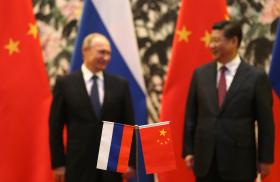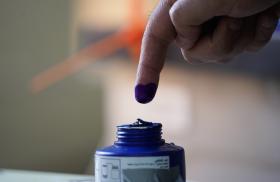
- Policy Analysis
- Interviews & Presentations
Hope for al-Hol? The Syria Breakdown, Episode Six

Part of a series: The Syria Breakdown
or see Part 1: Making Sense of Syria Sanctions: The Syria Breakdown, Part Seven
Does Syria's transition away from Assad regime tyranny offer hope for closing detention camps, which have been home to thousands of internally displaced persons and Islamic State supporters?
Syria today is drastically different than it has been in the past. The Assad regime is no longer, the U.S. is less active than it has been previously, and the future of Syria remains in question. In addition to these new unknowns, old problems persist with several unanswered questions. One of those unanswered questions is the al-Hol detention camp in northeast Syria, and what its future holds in this new Syria, where U.S. troops might no longer remain.
Originally created as an internally displaced persons camp and run by the United Nations, al-Hol has a population that ballooned after the fall of the Islamic State’s “caliphate,” with the camp becoming closed—meaning residents were not free to leave as they would with a traditional IDP camp. The camp is run by U.S. local partner the Kurdish-led Syrian Democratic Forces (SDF) and funded by the United States and international donations. The camp holds both Syrian and Iraqi IDPs who were there before March 2019 as well as an influx of Islamic State–affiliated families captured at the terrorist group’s last stand at Baghuz, Syria, in March 2019.
Today, the question remains of what should be done with the thousands of Islamic State–affiliated families living side by side with Syrian and Iraqi IDPs in dangerous and deadly conditions, guarded by SDF soldiers now unsure of their once-solid U.S support? Furthermore, what chance is there to stop this from growing into a bigger problem?
My name is Dr. Devorah Margolin, and I am the Blumenstein-Rosenbloom Senior Fellow here at the Washington Institute for Near East Policy. As of January 2025, al-Hol camp holds approximately 40,000 people, including 16,000 Syrians, 17,600 Iraqis, 6,400 third-country nationals. About 24,400 camp residents are under the age of eighteen. A smaller camp about sixty miles away, Roj, holds 2,600 individuals, 80% of whom are third-country nationals.
Much has been detailed about the state of the detention camps, including the devastating humanitarian and precarious security situation there, made worse by the fact that many of these individuals have been held for more than five years. The facilities suffer from numerous humanitarian challenges, including lack of food, water, education, and healthcare. Maintaining order in these volatile camps has proven to be difficult. And they remain vulnerable to outside attack from Islamic State fighters seeking to free their supporters. While the maintenance of security and aid to the camp is vital, the detention of thousands of people is not sustainable—and should not be indefinite.
As the U.S. led-Global Coalition has repeated over the last five years, the number-one solution to detention camps like al-Hol and Roj is the repatriation of citizens to their countries of origin. There have, of course, been barriers to repatriation and decreasing the detainee population. For example, the civil war in Syria has divided the country into many different spheres of influence and control. Specifically, the northeast of Syria, where Islamic State affiliates have been held, has been under the control of a nonstate actor—the Autonomous Administration of North and East Syria (AANES), not the former Assad regime. Because of this and the closed nature of the camp, organizations like the United Nations have chosen not to continue their work in the camp, which means funding is dependent on foreign donations, like from the U.S. State Department, which can be left up to political changes.
Another issue is the nonstate status of the SDF—the military arm of AANES. Unlike other entities that have administered similar camps, the SDF is not a state actor. And our close NATO ally Turkey accuses the SDF of being a terrorist organization due to its links to a U.S.-designated terrorist group, the Kurdistan Workers Party (PKK). The SDF’s nonstate status has had several knock-on effects, including when it comes to repatriation itself, which has been largely voluntary as the SDF cannot deport citizens to their countries of origin. Some countries also refuse to work with the SDF because it is a nonstate actor.
The Syrian civil war and the division of the country have also affected return for Syrians themselves held at al-Hol, who could not be returned to Assad-controlled areas due to insecurity and human rights violations occurring under the former regime. But barriers also come from outside Syria, as different countries deal with varying levels of political will or capability to repatriate their citizens. This includes countries dealing with large populations, others that lack the resources, and even those that lack the political will to repatriate. There are also countries where it would be irresponsible to repatriate citizens due to possible human rights violations.
Even among those countries that do repatriate citizens, the majority only return women and children, ignoring men and teenage boys. Yet throughout the last five years, despite these barriers, returns and repatriations have continued:
- Approximately 11,000 Syrians left al-Hol since 2020 for the northeast.
- Since 2021, more than 15,000 Iraqis have been repatriated, including approximately 14,000 from al-Hol and 1,200 from prisons in northeast Syria.
- Finally, more than 3,760 third-country nationals have been repatriated to forty countries since 2019, with countries like Kazakhstan and Kyrgyzstan repatriating more than five hundred people each.
Today, we are facing a different Syria, one where many of the barriers that were in place are no longer there. Namely, the Assad regime is no longer in control, and Syria has moved toward reconciliation between different factions, including conversations between the SDF and the transitional government in Damascus. While this process is very much in transition, a new unified Syrian government could take several steps related to populations detained in northeast Syria:
- While Syrian populations in al-Hol could previously only return to the northeast, a unified Syria without Assad allows for the possibility of displaced Syrians to return to all of Syria. This could rapidly decrease the population of al-Hol, where 16,000 Syrians still make up 40 percent of the camp’s population. To make this a reality, though, the humanitarian crisis and security situation across all of Syria must be addressed so that people will want to return to their homes.
- The new unified Syrian government would have the power to deport people to their countries of origin. This is a drastic shift from the SDF, which relied on voluntary returns. For countries long reluctant to repatriate, like those in Europe and the Middle East, the option to ignore the repatriation issue could become irrelevant.
- Iraq—with 17,600 Iraqis making up 44 percent of the population in al-Hol—has agreed to repatriate all its citizens by 2027.
Taken together, these factors could greatly influence and decrease the population in al-Hol, turning the former unsolvable solution into a more solvable one. Repatriation will not solve all the problems in Syria, but the alternative—leaving individuals behind—creates a much greater risk to the stability of Syria and the international community.
Devorah Margolin is the Blumenstein-Rosenbloom Senior Fellow at The Washington Institute.




